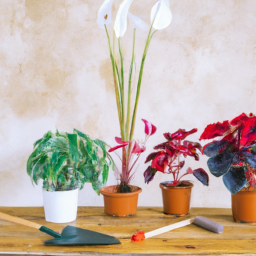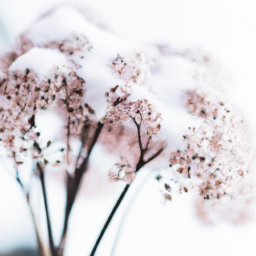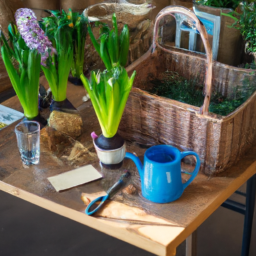
Spring Awakening: Preparing Your Indoor Garden
As the winter frost begins to thaw and the days grow longer, it’s time to embrace the arrival of spring and breathe new life into our homes. While many of us eagerly await the blooming of outdoor gardens, there is a delightful alternative for those who don’t have access to outdoor spaces or simply want to bring a touch of nature indoors – indoor gardening. With the arrival of spring, it’s the perfect time to start preparing your indoor garden and create a vibrant oasis right in the comfort of your own home. Whether you’re a seasoned green thumb or a novice plant enthusiast, this blog post will guide you through the steps to ensure a successful and thriving indoor garden this spring. So, let’s dive in and discover the secrets to cultivating a flourishing indoor garden that will awaken your senses and bring the beauty of spring right to your doorstep.
Spring Awakening: Preparing Your Indoor Garden
Choosing the Right Plants for Your Indoor Garden
Welcome to the world of indoor gardening! With spring just around the corner, it’s the perfect time to start preparing your indoor garden. Whether you have a small apartment or a spacious house, indoor gardening allows you to bring the beauty of nature indoors and create a serene and vibrant atmosphere. In this guide, we will walk you through the process of choosing the right plants for your indoor garden, ensuring that you have a successful and rewarding gardening experience.
Understanding Your Indoor Environment
Before diving into the world of indoor gardening, it’s important to understand your indoor environment. Different plants have different light, temperature, and humidity requirements. Assess the conditions in your home to determine the best plants for your space. Consider the amount of natural light your indoor garden receives, the average temperature, and the humidity levels. This will help you choose plants that thrive in your specific environment.
If you have a sunny window or a balcony that receives ample sunlight, you can opt for sun-loving plants like succulents, herbs, or flowering plants. On the other hand, if your space is limited and lacks natural light, you can choose low-light tolerant plants such as snake plants, pothos, or peace lilies. Understanding your indoor environment will ensure that your plants receive the right amount of light and temperature for their growth.
Additionally, consider the humidity levels in your home. Some plants, like ferns and orchids, prefer higher humidity, while others, like cacti and succulents, thrive in drier conditions. You can create a more humid environment by placing a tray filled with water near your plants or by using a humidifier. Understanding the humidity requirements of your chosen plants will help you provide the ideal growing conditions.
Choosing the Right Plants
Now that you have assessed your indoor environment, it’s time to choose the right plants for your indoor garden. There is a wide variety of plants to choose from, each with its own unique characteristics and care requirements. Here are a few popular options to consider:
Succulents
Succulents are perfect for indoor gardening, especially if you have limited space and sunlight. These plants store water in their leaves, making them drought-tolerant and low-maintenance. They come in various shapes, sizes, and colors, adding a touch of beauty to any indoor space. Some popular succulent varieties include aloe vera, jade plants, and echeveria.
Herbs
If you enjoy cooking or simply love the aroma of fresh herbs, growing herbs indoors is a great choice. Herbs like basil, parsley, mint, and rosemary thrive in containers and can be easily grown on a windowsill or under artificial lights. Not only do they add a fresh and vibrant touch to your indoor garden, but they also provide you with a ready supply of flavorful herbs for your culinary adventures.
Flowering Plants
Bring a burst of color and fragrance to your indoor garden with flowering plants. African violets, orchids, and peace lilies are popular choices for indoor flowering plants. They require a bit more care and attention compared to succulents or herbs, but the beauty they bring to your space is well worth the effort. Flowering plants can create a soothing and calming atmosphere, making them perfect for bedrooms or living areas.
Caring for Your Indoor Plants
Once you have chosen the right plants for your indoor garden, it’s crucial to provide them with proper care and maintenance. Here are a few essential tips to ensure the health and vitality of your indoor plants:
Lighting
Most indoor plants require bright, indirect light to thrive. Place them near a window where they can receive sufficient sunlight without being exposed to direct sunlight, which can scorch their leaves. If natural light is limited, you can use artificial grow lights specifically designed for indoor plants. Position the lights about 6-12 inches above the plants and adjust the duration of light exposure based on the specific needs of your plants.
Watering
Proper watering is essential for the health of your indoor plants. Overwatering can lead to root rot, while underwatering can cause wilting and dehydration. The watering frequency and amount depend on the specific plant species and the environmental conditions. Before watering, check the moisture level of the soil by inserting your finger about an inch deep. If it feels dry, it’s time to water. Ensure that the water drains properly from the pot to prevent waterlogging.
Fertilizing
Indoor plants generally require less frequent fertilization compared to outdoor plants. Use a balanced, water-soluble fertilizer specifically formulated for houseplants. Follow the instructions on the fertilizer package for the correct dosage and frequency. Overfertilization can lead to nutrient burn, so it’s important not to exceed the recommended amounts. Fertilize your plants during the growing season (spring and summer) and reduce or stop fertilization during the dormant period (fall and winter).
Caring for your indoor plants involves observing their growth, monitoring their watering needs, and providing the right amount of light and nutrients. With proper care, your indoor garden will flourish and bring joy and tranquility to your home.
Conclusion
Creating an indoor garden is a wonderful way to embrace the arrival of spring and infuse your home with natural beauty. By understanding your indoor environment, choosing the right plants, and providing proper care, you can create a thriving indoor garden that will bring you joy and relaxation throughout the year. So, get ready to awaken your indoor space with the vibrant colors and refreshing scents of nature!
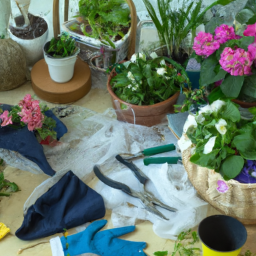
Spring Awakening: Preparing Your Indoor Garden
2. Essential Tips for Creating the Perfect Indoor Garden Environment
Creating a beautiful and thriving indoor garden is a wonderful way to bring the freshness and vibrancy of spring into your home. Whether you have a green thumb or are just starting out, these essential tips will guide you in preparing the perfect environment for your indoor garden. From choosing the right plants to providing adequate light and moisture, let’s dive into the world of indoor gardening.
Choosing the Right Plants
When it comes to indoor gardening, selecting the right plants is crucial for success. Consider the following factors when choosing plants for your indoor garden:
1. Light Requirements: Different plants have varying light requirements. Assess the lighting conditions in your home and choose plants accordingly. Some plants thrive in bright, direct sunlight, while others prefer indirect or low light conditions.
2. Space Availability: Take into account the available space in your home. If you have limited space, opt for smaller plants or those that can be easily placed on shelves or windowsills. If you have more room, consider larger plants or even small trees to create a lush indoor garden.
3. Maintenance Level: Consider your level of commitment to plant care. Some plants require more attention and care, while others are low-maintenance. Choose plants that align with your lifestyle and the amount of time you can dedicate to their care.
By carefully selecting plants that suit your specific environment and lifestyle, you’ll set the foundation for a thriving indoor garden.
Providing Adequate Light
Light is one of the most important factors for the health and growth of your indoor plants. Follow these tips to ensure your plants receive adequate light:
1. Assess Natural Light: Observe the natural light conditions in your home. Identify areas that receive direct sunlight and those that have indirect or low light. This will help you determine the best spots for your plants.
2. Choose the Right Location: Place your plants near windows that receive the appropriate amount of light for their specific needs. South-facing windows generally provide the most light, while north-facing windows offer the least. East and west-facing windows provide moderate light.
3. Supplement with Artificial Light: If your home lacks sufficient natural light, consider using artificial light sources such as fluorescent or LED grow lights. These lights can provide the necessary light spectrum for optimal plant growth.
Remember to monitor your plants regularly and adjust their position if they show signs of inadequate or excessive light. Striking the right balance will ensure your indoor garden thrives.
Maintaining Proper Moisture Levels
Watering your indoor plants correctly is essential for their overall health. Follow these guidelines to maintain proper moisture levels:
1. Understand Plant Watering Needs: Different plants have different watering requirements. Some prefer to dry out slightly between waterings, while others require consistently moist soil. Research the specific needs of your plants and create a watering schedule accordingly.
2. Use Well-Draining Soil: Ensure your plants are potted in well-draining soil to prevent waterlogging. This allows excess water to escape and prevents root rot. You can also add perlite or sand to improve soil drainage.
3. Watering Techniques: When watering your plants, aim to moisten the entire root ball. Avoid overwatering, as it can lead to root rot and other issues. Allow the top inch of soil to dry out before watering again.
Additionally, consider the humidity levels in your home. Some plants thrive in high humidity, while others prefer drier conditions. Use a humidifier or pebble tray to increase humidity if necessary.
With proper watering techniques and attention to humidity levels, your indoor garden will flourish and bring the beauty of spring indoors.
Creating and maintaining an indoor garden is a rewarding experience that allows you to enjoy the wonders of nature year-round. By choosing the right plants, providing adequate light, and maintaining proper moisture levels, you’ll create the perfect environment for your indoor garden to thrive. So, roll up your sleeves, get your hands dirty, and let your indoor garden awaken with the freshness of spring!
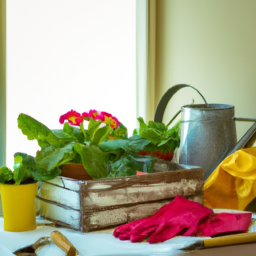
Spring Awakening: Preparing Your Indoor Garden
3. Maintaining and Caring for Your Indoor Garden in Spring
Now that you have successfully prepared your indoor garden for spring, it’s important to know how to maintain and care for it to ensure healthy growth and vibrant blooms. In this section, we will discuss some essential steps and tips to help you keep your indoor garden thriving throughout the season.
Proper Watering Techniques
Watering your indoor plants is crucial for their survival and growth. However, it’s important to strike a balance and not overwater or underwater them. Here are some tips for proper watering:
1. Check the moisture level: Before watering your plants, check the moisture level of the soil by inserting your finger about an inch deep. If it feels dry, it’s time to water. If it’s still moist, wait for a day or two and check again.
2. Water thoroughly: When watering, make sure to thoroughly saturate the soil until water drains out from the bottom of the pot. This helps to flush out any accumulated salts or toxins and ensures proper hydration for the roots.
3. Avoid waterlogging: Always empty the saucers or trays underneath the pots after watering to prevent waterlogging, which can lead to root rot and other diseases.
4. Be mindful of humidity: In spring, the humidity levels tend to rise. If you notice excessive moisture in the air, reduce the frequency of watering to prevent mold or fungal growth.
Pruning and Trimming
Regular pruning and trimming are essential for maintaining the shape, health, and overall appearance of your indoor plants. Here’s how to do it effectively:
1. Remove dead or yellowing leaves: Inspect your plants regularly and remove any dead or yellowing leaves. These can be a sign of disease or nutrient deficiencies and can also attract pests.
2. Trim overgrown branches: If you notice any branches or stems that have become too long or leggy, use clean pruning shears to trim them back. This will encourage new growth and help maintain a compact shape.
3. Pinch off spent flowers: If your indoor plants produce flowers, make sure to pinch off any spent flowers to redirect the plant’s energy towards new growth rather than seed production. This will promote continuous blooming.
4. Prune for air circulation: If you have dense foliage, consider selectively pruning some leaves to improve air circulation within the plant. Good airflow helps prevent diseases and allows for better nutrient absorption.
Fertilizing Indoor Plants
While indoor plants can derive some nutrients from the potting soil, they often require additional fertilization to thrive. Here are some tips for fertilizing your indoor garden:
1. Choose the right fertilizer: Select a balanced fertilizer specifically formulated for indoor plants. Look for a ratio such as 10-10-10, which indicates equal proportions of nitrogen (N), phosphorus (P), and potassium (K).
2. Follow the instructions: Read the instructions on the fertilizer packaging carefully and follow the recommended dosage. Over-fertilizing can burn the roots, so it’s better to err on the side of caution and apply less than recommended.
3. Apply during active growth: Fertilize your indoor plants during their active growth period, which is usually in spring and summer. Avoid fertilizing during the dormant period, as plants require fewer nutrients during this time.
4. Use organic alternatives: If you prefer organic options, consider using compost or organic plant food. These provide slow-release nutrients and improve soil structure over time.
Remember to always monitor your plants’ response to fertilization and make adjustments accordingly. Some plants may have specific fertilization requirements, so it’s essential to research their individual needs.
With these tips and techniques, you can confidently maintain and care for your indoor garden throughout the spring season. Regular watering, proper pruning, and adequate fertilization will ensure healthy, vibrant plants that bring joy and beauty to your home.
Summary Snapshot
Spring is finally here, and with it comes the perfect opportunity to prepare your indoor garden for the season. Whether you’re a seasoned gardener or just starting out, there are a few key steps you can take to ensure your plants thrive and flourish. First and foremost, it’s important to assess the lighting situation in your home. Most plants require ample sunlight, so be sure to place them near windows or invest in artificial grow lights if needed. Additionally, consider the temperature and humidity levels in your space. Many plants prefer a slightly warmer and more humid environment, so you may need to adjust your thermostat or use a humidifier to create the ideal conditions.
Once you have the basics covered, it’s time to think about the specific needs of your plants. Research what type of soil, fertilizer, and watering schedule each plant requires, as these can vary greatly. It’s also a good idea to check for any signs of pests or diseases, and take appropriate measures to prevent or treat them. Finally, don’t forget to give your plants some TLC by regularly pruning, repotting, and removing any dead or yellowing leaves. By following these simple steps, you’ll be well on your way to a vibrant and thriving indoor garden this spring.
Here are the top questions that we were asked:
Q1: What are some popular indoor plants that thrive during spring?
A1: There are several indoor plants that flourish during spring. Some popular choices include the peace lily, spider plant, pothos, snake plant, and Boston fern. These plants are known for their ability to adapt to indoor conditions and can bring a refreshing touch of greenery to your indoor garden.
Q2: How should I prepare my indoor garden for spring?
A2: Preparing your indoor garden for spring involves a few key steps. Start by cleaning your plants’ leaves to remove dust and promote better photosynthesis. Check for any signs of pests or diseases and treat them accordingly. It’s also a good time to repot any plants that have outgrown their containers. Lastly, consider adjusting your watering and fertilizing routine to accommodate the increased growth during spring.
Q3: What lighting conditions are ideal for indoor gardens in spring?
A3: In spring, most indoor plants benefit from bright, indirect sunlight. Place your plants near windows that receive filtered light throughout the day. Avoid exposing them to direct sunlight, as it can scorch their leaves. If your indoor garden lacks natural light, consider using artificial grow lights to provide the necessary light spectrum for healthy growth.
Q4: How often should I water my indoor plants during spring?
A4: The watering frequency for indoor plants in spring can vary depending on factors like plant type, pot size, and environmental conditions. As a general guideline, check the moisture level of the soil regularly by sticking your finger about an inch deep. Water your plants when the top inch of soil feels dry. Remember to adjust the watering frequency based on your specific plant’s needs and the humidity levels in your home.
Q5: Are there any specific nutrients I should provide to my indoor plants during spring?
A5: Indoor plants benefit from regular fertilization during the spring season. Look for a balanced, water-soluble fertilizer specifically formulated for houseplants. Follow the instructions on the packaging to determine the appropriate dosage and frequency. Generally, it’s recommended to fertilize indoor plants every two to four weeks during the growing season to promote healthy foliage and vibrant blooms.

James Wong is a renowned ethnobotanist, plant scientist, and local television presenter. With a passion for demystifying plant science, he is known for translating complex botanical concepts into practical advice for everyday plant enthusiasts. James’s expertise spans from traditional gardening to cutting-edge plant technologies, making his insights accessible and informative.

